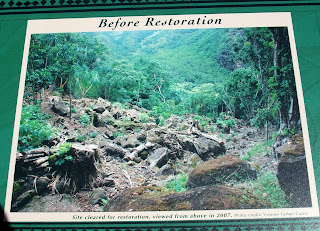 |
| The forest is divided in two: those that endanger and those that are endangered. |
 |
| Introduced plants can kill the native plants. The autograph tree can strangle other trees. |
 |
| The movie 'South Pacific' was filmed here. |
 |
| Streams were channeled into terraces to grow Kalo, better known as Taro. The root was pounded and used for Poi and the leaves as greens. Breadfruit, banana and cane grew here. |
 |
| Much of the natural forests have disappeared. Also, plants have been attacked by introduced insects. |
 |
| When this site was cleared, some native plants that were thought to be extinct were found. |
 |
| The 'canoe' garden had many fruits and flowers brought by the Polynesians. |
 |
| Lichen and mosses are likely native ... brought by wind/water. |
 |
| Maindenhair fern grow in the cracks of lava rocks. |
 |
| Makana is important in native ritual of throwing burning wood from the top during the ohai ceremony. |
 |
| There is an archaeological site with rock enclosures used for housing , some with their own pools to supply fresh water. |
 |
| This tree produces a canopy that stifled other plants. |
 |
| Some trees grow in symbiosis. It is not unusual to see philodendrons trailing from trees. |
 |
| This white hibiscus is a native species -one of the few living plants. It is located in the 'rare plants' garden. |
 |
| Hala is a native plant - an example was found in fossil form. |
 |
| As you come out of the forest area, the Ke'e Beach is below. |
 |
| This area was used to film Jurassic Park. |
 |
| Ground covers are in a sunny slope. |
 |
| This is a native plant with a 'half flower'. |
 |
| The Plumaria is fragrant and used for leis. It looses it's leaves in November and grows them in April. |
 |
| Sugar cane was brought from Polynesia and after contact became an industry. |
 |
| You can see why this area has a mystical feeling. |
 |
| There are many varieties of Taro. It is called 'big brother' and is held in reverance by the Hawaiians. |
 |
| Looking back. |
 |
| This is a drawing, showing what the settlement would have looked like. |














No comments:
Post a Comment